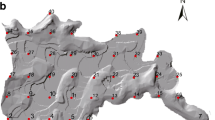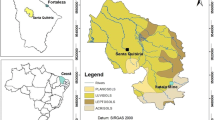Abstract
Brazil is the world’s largest sugarcane producer and soils in the northeastern part of the country have been cultivated with the crop for over 450 years. However, so far, there has been no study on the status of heavy metal accumulation in these long-history cultivated soils. To fill the gap, we collect soil samples from 60 sugarcane fields in order to determine the contents of Cd, Cr, Cu, Ni, Pb, and Zn. We used multivariate analysis to distinguish between natural and anthropogenic sources of these metals in soils. Analytical determinations were performed in ICP-OES after microwave acid solution digestion. Mean concentrations of Cd, Cr, Cu, Ni, Pb, and Zn were 1.9, 18.8, 6.4, 4.9, 11.2, and 16.2 mg kg−1, respectively. The principal component one was associated with lithogenic origin and comprised the metals Cr, Cu, Ni, and Zn. Cluster analysis confirmed that 68 % of the evaluated sites have soil heavy metal concentrations close to the natural background. The Cd concentration (principal component two) was clearly associated with anthropogenic sources with P fertilization being the most likely source of Cd to soils. On the other hand, the third component (Pb concentration) indicates a mixed origin for this metal (natural and anthropogenic); hence, Pb concentrations are probably related not only to the soil parent material but also to industrial emissions and urbanization in the vicinity of the agricultural areas.





Similar content being viewed by others
References
Almeida, B. G. (2008). Métodos alternativos de determinação de parâmetros físicos do solo e uso de condicionadores químicos no estudo da qualidade do solo, These, College of Agriculture Luiz de Queiroz (in Portuguese).
Araujo, W. S., Amaral Sobrinho, N. M. B., Mazur, N., & Gomes, P. C. (2002). Relação entre adosorção de metais pesados e atributos químicos e físicos de classes de solo do Brasil. Revista Brasileira de Ciência do Solo, 26, 17–27.
Biondi, C. M. (2010). Teores naturais de metais pesados nos solos de referência do estado de Pernambuco, These, Federal Rural University of Pernambuco (in Portuguese).
Biondi, C. M., Nascimento, C. W. A., Fabrício Neta, A. B., & Ribeiro, M. R. (2011). Teores de Fe, Mn, Zn, Cu, Ni e Co em solos de referência de Pernambuco. Revista Brasileira de Ciência do Solo, 35, 1057–1066.
Blume, H. P., & Brümmer, G. (1987). Prognose des Verhaltens der Schwermetalle in Böden mit einfachen Feldmethoden. Mitteilungen der Deutschen Bodenkundlichen Gesellschaf, 53, 111–117 (in German).
Carvalho, V. G. B., Nascimento, C. W. A., & Biondi, C. M. (2012). Potencial de fertilizantes e corretivos no aporte de micronutrientes ao solo. Revista Brasileira de Ciência do Solo, 36, 931–938.
Conama (2009). Conselho Nacional do Meio Ambiente, no 420/2009, “Dispõe sobre critérios e valores orientadores de qualidade do solo quanto à presença de substâncias químicas e estabelece diretrizes para o gerenciamento ambiental de áreas contaminadas por essas substâncias em decorrência de atividades antrópicas”.http://www.mma.gov.br/port/conama/legiabre.cfm?codlegi=620. Accessed 10 Jan 2014.
Conceicao, F. T., Navarro, G. R. B., & Silva, A. M. (2013). Anthropogenic influences on Cd, Cr, Cu, Ni, Pb and Zn concentrations in soils and sediments in a watershed with sugar cane crops at São Paulo state, Brazil. International Journal Environmental Research, 7, 551–560.
CPRH (2014). Agência Estadual do Meio Ambiente, no 07/2014, “Estabelece os valores de referência da qualidade do solo (VRQ) do Estado de Pernambuco quanto à presença de substâncias químicas para o gerenciamento ambiental de áreas contaminadas por essas substâncias”. https://www.legisweb.com.br/legislacao/?id=279789. Accessed 25 Jan 2015.
Crannell, B. S., Eighmy, T. T., Krzanowski, J. E., Eusden, J. D., Shaw, E. L., & Francis, C. A. (2000). Heavy metal stabilization in municipal solid waste combustion bottom ash using soluble phosphate. Waste Management, 20, 135–148. doi:10.1016/S0956-053X(99)00312-8.
Cui, Y. J., Zhu, Y. G., Zhai, R. H., Chen, D. Y., Huang, Y. Z., Qiu, Y., et al. (2004). Transfer of metals from soil to vegetables in an area near a smelter in Nanning, China. Environment International, 30, 785–791. doi:10.1016/j.envint.2004.01.003.
Czarnecki, S., & Düring, R. A. (2015). Influence of long-term mineral fertilization on metal contents and properties of soil samples taken from different locations in Hesse, Germany. The Soil, 1, 23–33. doi:10.5194/soil-1-23-2015.
Elik, A. (2003). Heavy metal accumulation in street dust samples in Sivas. Communications in Soil Science and Plant Analysis, 34, 145–156.
Freitas, E. V. S., Nascimento, C. W. A., Goulart, D. F., & Silva, J. P. S. (2009). Disponibilidade de cádmio e chumbo para milho em solo adubado com fertilizantes fosfatados. Revista Brasileira Ciência do Solo, 33, 1899–1907. doi:10.1590/S0100-06832009000600039.
Freyre, G. M. (1964). The masters and the slaves: a study in the development of Brazilian civilization. Los Angeles: University of California Press.
Grant, C. A. (2011). Influence of phosphate fertilizer on cadmium in agricultural soils and crops. Pedologist. 143–155.
Guilherme, L. R. G., & Anderson, S. J. (1998). Copper sorption kinetics and sorption hysteresis in two oxide-rich soils (Oxisols): effect of phosphate pretreatment. In E. A. Jene (Ed.), Adsorption of metals by geomedia: variables, mechanisms and model applications (pp. 209–228). San Diego: Academic Press.
Hu, Y., Liu, X., Bai, J., Shih, K., Zeng, E. Y., & Cheng, H. (2013). Assessing heavy metal pollution in the surface soils of a region that had undergone three decades of intense industrialization and urbanization. Environmental Science and Pollution Research, 20, 6150–6159. doi:10.1007/s11356-013-1668-z.
INMET (2015). Instituto Nacional de Meteorologia, Normas Climatológicas (1961–1990). http://www.inmet.gov.br/portal/index.php?r=clima/normaisClimatologicas. Accessed 17 may 2015.
IUSS Working Group WRB (2014). World reference base for soil resources 2014. International soil classification system for naming soils and creating legends for soil maps, World Soil Resources Reports No. 106. doi:10.1017/S0014479706394902
Kabata-Pendias, A. (2011). Trace elements in soils and plants. Washigton, DC: CRC.
Kelepertzis, E. (2014). Accumulation of heavy metals in agricultural soils of Mediterranean: insights from Argolida basin, Peloponnese, Greece. Geoderma, 221-222, 82–90. doi:10.1016/j.geoderma.2014.01.007.
Li, W., Xu, B., Song, Q., Liu, X., Xu, J., & Brookes, P. C. (2014). The identification of “hotspots” of heavy metal pollution in soil-rice systems at a regional scale in eastern China. Science of the Total Environment, 472, 407–420. doi:10.1016/j.scitotenv.2013.11.046.
Lottermoser, B. G. (2009). Trace metal enrichment in sugarcane soils due to the long-term application of fertilizers, North Queensland, Australia: geochemical and Pb, Sr and U isotopic composition. Soil Research, 47(3), 311–320.
Ma, L. Q. (1996). Factors influencing the effectiveness and stability of aqueous Pb immobilization by hydroxyapatite. Journal of Environmental Quality, 25, 1420–1429.
McGeorge, W. T. (1954). Diagnosis and improvement of saline and alkaline soils. Washigton, DC: United States Department of Agriculture.
Micó, C., Recatalá, L., Peris, M., & Sánchez, J. (2006). Assessing heavy metal sources in agricultural soils of an European Mediterranean area by multivariate analysis. Chemosphere, 65, 863–872. doi:10.1016/j.chemosphere.2006.03.016.
Mendes, A. M. S., Duda, G. P., Nascimento, C. W. A., & Silva, M. O. (2006). Bioavailability of cadmium and lead in a soil amended with phosphorus fertilizers. Scientia Agricola, 63, 328–332. doi:10.1590/S0103-90162006000400003.
MAPA (2006). Ministério da Agricultura, Pecuária e Abastecimento, no 27/2006, “Dispõe sobre fertilizantes, corretivos, inoculantes e biofertilizantes, para serem produzidos, importados ou comercializados, deverão atender aos limites estabelecidos nos anexos I, II, III e IV desta Instrução Normativa no que se refere às concentrações máximas admitidas para agentes fitotóxicos, patogênicos ao homem, animais e plantas, metais pesados, pragas e ervas daninhas”. http://agrolab.com.br/documento/13. Acessed 11 June 2014.
Naidu, R., Sumner, M., & Harter, R. (1998). Sorption of heavy metals in strongly weathered soils: an overview. Environmental Geochemistry and Health, 20, 5–9. doi:10.1023/A:1006519009465.
Naveedullah, Hashmi, M. Z., Yu, C., Shen, H., Duan, D., Shen, C., et al. (2013). Risk assessment of heavy metals pollution in agricultural soils of Siling reservoir watershed in Zhejiang Province, China. BioMed Research International, 2013, 1–10.
Neves, M. F., Trombin, V. G., & Consoli, M. (2011). The sugar energy map of Brazil in ethanol and bioelectricity: sugarcane in the future of the energy matrix. São Paulo: Unica.
Nicholson, F. A., Smith, S. R., Alloway, B. J., Carlton-Smith, C., & Chambers, B. J. (2006). Quantifying heavy metal inputs to agricultural soils in England and Wales. Water Environment Journal, 20, 87–95. doi:10.1111/j.1747-6593.2006.00026.x.
Niu, L., Yang, F., Xu, C., Yang, H., & Liu, W. (2013). Status of metal accumulation in farmland soils across China: from distribution to risk assessment. Environmental Pollution, 176, 55–62. doi:10.1016/j.envpol.2013.01.019.
Nriagu, J. O. (1984). Formation and stability of base metal phosphates in soil and sediments. In J. O. Niagru & P. B. Moore (Eds.), Phosphates minerals (pp. 318–329). London: Springer.
Oliveira, L. F. C., Lemke-de-Castro, M. L., Rodrigues, C., & Borges, J. D. (2010). Isotermas de sorção de metais pesados em solos do cerrado de Goiás. Revista Brasileira de Engenharia Agrícola e Ambiental, 14, 776–782. doi:10.1590/S1415-43662010000700014.
Parelho, C., Rodrigues, A. S., Cruz, J. V., & Garcia, P. (2014). Linking trace metals and agricultural land use in volcanic soils - a multivariate approach. Science of the Total Environment, 496, 241–247. doi:10.1016/j.scitotenv.2014.07.053.
Peris, M., Micó, C., Recatalá, L., Sánchez, R., & Sánchez, J. (2007). Heavy metal contents in horticultural crops of a representative area of the European Mediterranean region. Science of the Total Environment, 378, 42–48. doi:10.1016/j.scitotenv.2007.01.030.
Roberts, T. L. (2014). Cadmium and phosphorous fertilizers: the issues and the science. Procedia Enginnering, 83, 52–59. doi:10.1016/j.proeng.2014.09.012.
Schroder, J. L., Basta, N. T., Lochmiller, R. L., Rafferty, D. P., Payton, M., Kim, S., et al. (2000). Soil contamination and bioaccumulation of inorganics on petrochemical sites. Environmental Toxicology and Chemistry, 19, 2066–2072.
Silva, A. C., Torrado, P. V., Junior, J. de S. A. (1999). Methods of quantification of the organic matter of the soil. Revista da Universidade de Alfenas, 5, 21–26.
Sun, C., Liu, J., Wang, Y., Sun, L., & Yu, H. (2013). Multivariate and geostatistical analyses of the spatial distribution and sources of heavy metals in agricultural soil in Dehui, Northeast China. Chemosphere, 92, 517–523. doi:10.1016/j.chemosphere.2013.02.063.
Swartjes, F. A., Rutgers, M., Lijzen, J. P. A., Janssen, P. J. C. M., Otte, P. F., Wintersen, A., et al. (2012). State of the art of contaminated site management in the Netherlands: policy framework and risk assessment tools. Science of the Total Environment, 427-428, 1–10. doi:10.1016/j.scitotenv.2012.02.078.
Thompson, C. M., Markesbery, W. R., Ehmann, W. D., Mao, Y. X., & Vance, D. E. (1988). Regional brain trace-element studies in Alzheimer’s disease. Neurotoxicology, 9, 1–7.
USEPA (1998). U.S Environmental Protection Agency, Method 3051 A: Microwave assisted acid digestion of sediments, sludges, soils, and oils.
Wei, B., & Yang, L. (2010). A review of heavy metal contaminations in urban soils, urban road dusts and agricultural soils from China. Microchemical Journal, 94, 99–107. doi:10.1016/j.microc.2009.09.014.
Yang, P., Yang, M., Mao, R., & Shao, H. (2014). Multivariate-statistical assessment of heavy metals for agricultural soils in northern China. The Scientific World Journal, 2014, 1–7.
Author information
Authors and Affiliations
Corresponding author
Rights and permissions
About this article
Cite this article
da Silva, F.B.V., do Nascimento, C.W.A., Araújo, P.R.M. et al. Assessing heavy metal sources in sugarcane Brazilian soils: an approach using multivariate analysis. Environ Monit Assess 188, 457 (2016). https://doi.org/10.1007/s10661-016-5409-x
Received:
Accepted:
Published:
DOI: https://doi.org/10.1007/s10661-016-5409-x




